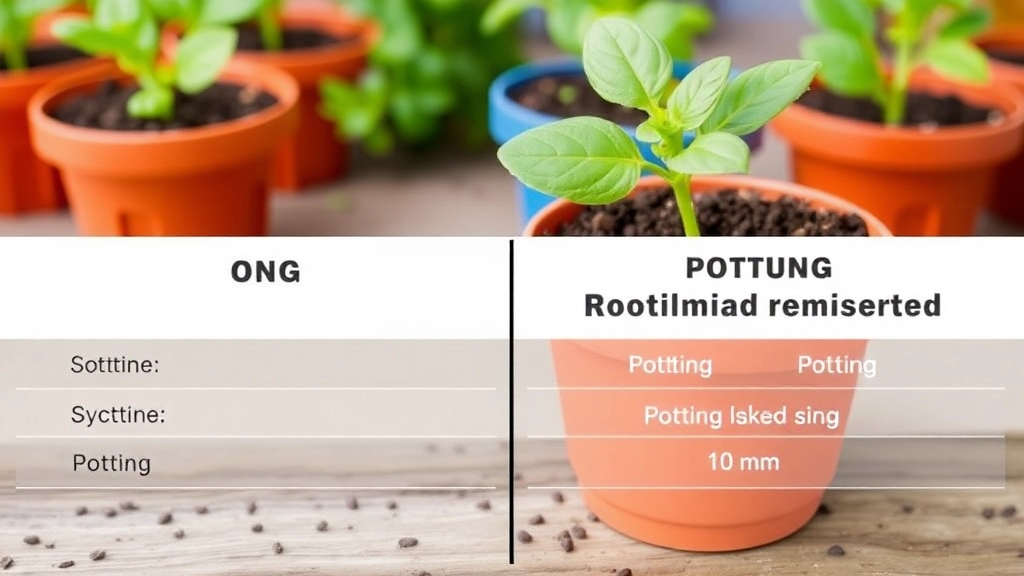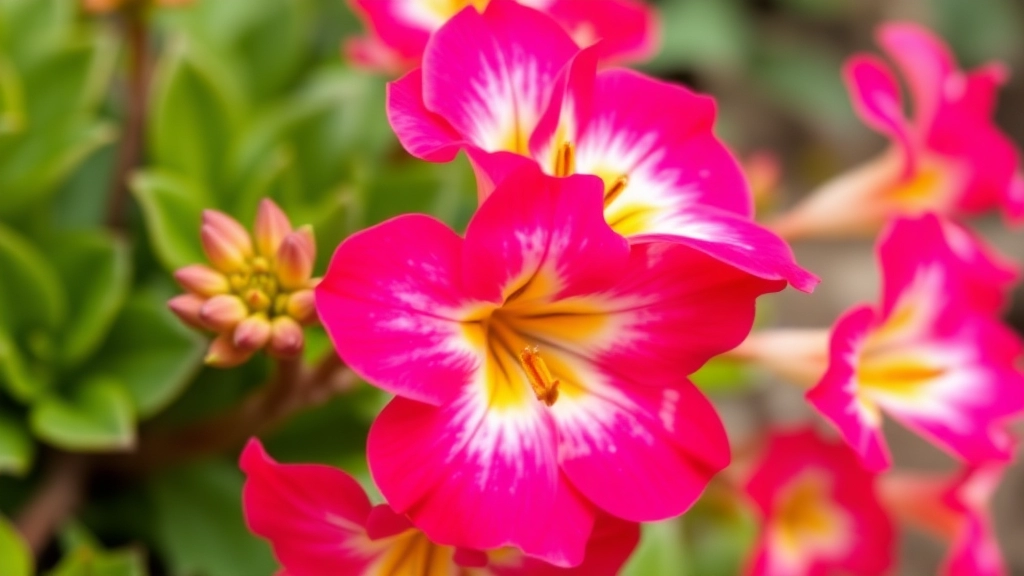Welcome, plant enthusiasts!
Today, we’re diving into the vibrant world of the Flaming Katy, also known as Kalanchoe blossfeldiana. This stunning succulent is about to become your new favorite houseplant, and I’m here to tell you why. With its fiery blooms and easy-going nature, Flaming Katy is like a little firework that keeps on giving. Whether you’re a seasoned green thumb or just starting your plant parent journey, this article will guide you through everything you need to know about this colorful charmer.
From its dazzling variety of colors to its low-maintenance care routine, we’ll explore why Flaming Katy has captured the hearts of plant lovers worldwide. Get ready to discover the secrets of keeping your Kalanchoe thriving, blooming, and brightening up your space all year round. So, grab a cuppa, settle in, and let’s unravel the magic of the Flaming Katy together!
Overview of Flaming Katy (Kalanchoe Blossfeldiana)
Ever stumbled upon a plant that’s like a firework in slow motion? That’s Flaming Katy for you.
Also known as Kalanchoe Blossfeldiana, this little powerhouse is a game-changer in the succulent world.
Why? It’s got attitude, colour, and it’s tough as nails.
Let’s break it down:
- Native to Madagascar (exotic, right?)
- Part of the Crassulaceae family (fancy name for succulents)
- Blooms in clusters of tiny, vibrant flowers
- Leaves are thick and glossy (perfect for water storage)
Here’s the kicker: Flaming Katy isn’t just a pretty face.
It’s got some serious survival skills.
Drought-resistant? Check.
Low maintenance? Double-check.
But here’s where it gets interesting:
Flaming Katy is a master of disguise.
One day it’s all green and unassuming, the next it’s exploding with colour.
It’s like having a surprise party in a pot.
And the best part? You don’t need a green thumb to keep it alive.
Trust me, I’ve killed my fair share of plants, but Flaming Katy? It’s still kicking.
So, whether you’re a plant newbie or a seasoned pro, Flaming Katy’s got your back.
It’s the plant equivalent of that friend who’s always up for a good time but doesn’t need babysitting.
Ready to dive deeper into the world of Flaming Katy? Let’s go!
Varieties and Colors of Flaming Katy

Let’s dive into the world of Flaming Katy, shall we? This little beauty’s got more colors than a box of crayons, I swear. When I first started growing these, I had no idea there were so many varieties. It’s like a candy shop for plant lovers!
Kalanchoe Blossfeldiana Colors:
- Red (the classic, can’t go wrong)
- Pink (from soft blush to hot pink)
- Orange (like a mini sunset)
- Yellow (bright as a summer day)
- White (clean and crisp)
- Purple (royal and rich)
But here’s the kicker – you can find bi-color varieties too. Imagine a flower that’s yellow with red edges. Crazy, right?
Popular Varieties:
- ‘Calandiva’: Double flowers, looks fancy
- ‘Flaming Katy’: The OG, single flowers
- ‘Mirabella’: Huge flowers, real show-off
- ‘Jacqueline’: Tiny flowers, but loads of ’em
Now, you might be thinking, “Which one should I get?” Honestly, it’s like picking your favorite ice cream flavor. They’re all good! But here’s a tip: if you’re new to this, start with the classic red Flaming Katy. It’s hardy and forgiving, perfect for beginners.
I remember when I got my first Flaming Katy. It was a tiny red one, barely bigger than my palm. Fast forward a year, and it was blooming like crazy, filling my windowsill with color. That’s the magic of these plants – they’re not fussy, but they give you so much in return.
So, whether you’re after a fiery red or a soft pink, there’s a Flaming Katy out there for you. Mix and match, create a rainbow on your shelf. Trust me, once you start, it’s hard to stop collecting these colorful little gems.
Remember, no matter which variety you choose, they all need similar care. We’ll get into that in the next sections. But for now, just imagine the possibilities. Your own little kaleidoscope of Kalanchoes!
Ideal Growing Conditions
Alright, let’s dive into the ideal growing conditions for our Flaming Katy pals.
These colorful succulents aren’t too fussy, but they do have some preferences.
Here’s what they’re looking for:
Light:
- Bright, indirect sunlight is their jam
- 4-6 hours of light daily keeps ’em happy
- Too much direct sun? They’ll get sunburned leaves (ouch!)
Temperature:
- They’re cool with room temps between 60-75°F (15-24°C)
- Not fans of extreme heat or cold
- Keep ’em away from drafty windows or AC units
Humidity:
- Average room humidity works fine
- No need for extra misting or humidifiers
Soil:
- Well-draining soil is key
- Mix potting soil with perlite or sand for better drainage
Pot:
- Choose a pot with drainage holes
- Terracotta pots are great for preventing water retention
Space:
- They’re not big on crowding
- Give ’em room to spread their leaves
Remember, Flaming Katies are succulents at heart. They’re tough cookies but hate wet feet.
Got a sunny spot indoors? That’s perfect for your Flaming Katy to thrive.
By nailing these conditions, you’ll have a happy, blooming plant in no time.
Soil and Potting Requirements

Let’s talk dirt, folks. When it comes to Flaming Katy, getting the soil right is like nailing the foundation of a skyscraper – it’s crucial. I’ve seen too many people mess this up, so let’s break it down.
Soil Mix: The Secret Sauce
Here’s the deal: Flaming Katy loves well-draining soil. Think about it like this – would you want to sit in a puddle all day? Neither does your plant. Here’s my go-to mix:
- 2 parts potting soil
- 1 part perlite or coarse sand
- 1 part peat moss or coco coir
Why this combo? It’s all about balance, baby. The potting soil gives nutrients, the perlite or sand ensures drainage, and the peat moss or coco coir retains just enough moisture.
Pot Selection: Size Matters
Now, let’s talk pots. You might be tempted to go big, but hold your horses. Flaming Katy prefers to be a bit snug. Here’s the lowdown:
- Choose a pot 1-2 inches larger than the current root ball
- Make sure it has drainage holes (non-negotiable!)
- Terra cotta pots are great for preventing overwatering
Pro Tip: If you’re repotting, do it in spring when the plant’s in growth mode.
pH Level: The Goldilocks Zone
Flaming Katy isn’t too picky, but it does have a sweet spot. Aim for a pH between 6.0 and 6.5. It’s slightly acidic, just how this plant likes it.
Repotting Frequency: Don’t Overdo It
Here’s a mistake I see all the time – people repotting way too often. Flaming Katy actually likes being a bit root-bound. Repot every 2-3 years, or when you see roots peeking out of the drainage holes.
Bottom Line
Getting the soil and potting right for your Flaming Katy isn’t rocket science, but it does make a world of difference. Nail this, and you’re setting yourself up for a thriving, blooming beauty. Remember, well-draining soil in a snug pot is the key to Flaming Katy success. Now go get your hands dirty!
Watering and Humidity Needs
Hey there, plant pals! Let’s chat about keeping your Flaming Katy happy and hydrated.
Watering: The Golden Rule
First things first: Flaming Katy isn’t a fan of soggy feet.
Overwatering? That’s a big no-no.
Here’s the deal:
- Water when the top inch of soil feels dry
- Give it a good drink, then let it drain
- Avoid leaving water in the saucer
Pro tip: Stick your finger in the soil. If it’s dry, it’s time to water.
Seasonal Shifts
Summer: Your Katy might need more frequent watering.
Winter: Ease up a bit. The plant’s taking a breather.
Humidity: Not a Drama Queen
Good news! Flaming Katy isn’t fussy about humidity.
Average room humidity? Perfect.
But if you’re in a super dry spot:
- Mist the leaves occasionally
- Group it with other plants
- Use a pebble tray for a humidity boost
Warning Signs
Droopy leaves? You might be overwatering.
Crispy edges? Time to up the moisture game.
The Bottom Line
Flaming Katy’s watering needs are pretty chill. Not too wet, not too dry – just right.
Remember: It’s easier to save an underwatered plant than an overwatered one.
Got questions about your Flaming Katy’s watering needs? Drop ’em in the comments!
Light and Temperature Preferences

Alright, let’s chat about what makes Flaming Katy tick when it comes to light and temp. Trust me, get these right, and you’ll have a happy plant on your hands.
Light: The Goldilocks Zone
Flaming Katy’s a bit of a diva with light. Too much, and she’ll throw a fit. Too little, and she’ll sulk. Here’s the deal:
- Bright, indirect light is the sweet spot
- 4-6 hours of sunlight daily keeps her happy
- Morning sun? Great. Harsh afternoon rays? Not so much
Pro tip: If your Katy’s leaves are pale or stretching, she’s crying out for more light. But if they’re scorched or dropping, ease up on the sun exposure.
Temperature: Cozy, Not Toasty
Flaming Katy likes it warm, but not hot. Think of it like this:
- Ideal range: 15-25°C (60-75°F)
- Can handle a bit cooler at night
- Anything below 10°C (50°F)? That’s a no-go
Here’s a quick cheat sheet:
- Summer: Keep her cool, away from AC vents
- Winter: No drafty windows, please
- Sudden temp changes? She’ll drop leaves faster than you can say “Kalanchoe”
Remember, Flaming Katy’s originally from Madagascar. So, think tropical, but not scorching. Get the light and temp right, and you’ll have a blooming beauty on your hands.
Got a tricky spot in your home? Try this: use a light meter app on your phone. It’s a game-changer for finding that perfect Flaming Katy sweet spot.
Bottom line: Flaming Katy thrives with the right light and temperature. Nail these, and you’re well on your way to plant parent success.
Fertilizing Tips for Your Flaming Katy
Hey there, plant pals! Let’s chat about feeding your Flaming Katy.
These beauties don’t need much to thrive, but a little boost can work wonders.
Here’s the lowdown on keeping your Kalanchoe happy and healthy:
When to Fertilize:
- Spring and summer are prime time
- Hold off during autumn and winter
What to Use:
- Go for a balanced, water-soluble fertilizer
- Look for a 10-10-10 or 20-20-20 mix
How Often:
- Once a month during growing season
- Less is more – don’t overdo it!
Pro Tips:
- Dilute the fertilizer to half strength
- Always water before feeding
- Skip fertilizing for a few months after repotting
Watch Out For:
- Yellow leaves? Might be overfertilizing
- Slow growth? Could need a nutrient boost
Remember, Flaming Katies are tough cookies. They’ll forgive you if you forget a feeding or two.
Just keep an eye on your plant. It’ll tell you what it needs.
Happy growing, mates! Your Flaming Katy will be blooming brilliantly in no time.
Common Pests and Diseases

Let’s talk about the not-so-fun part of growing Flaming Katy: pests and diseases. Trust me, I’ve been there, and it’s no picnic. But don’t worry, I’ve got your back.
Pesky Invaders
First up, let’s chat about the critters that might crash your Kalanchoe party:
- Mealybugs: These little cotton-ball lookalikes love to suck the life out of your plant. Spot ’em early, and you’re golden.
- Spider mites: Tiny but mighty, these guys can do a number on your Flaming Katy if you’re not careful.
- Aphids: Small, green, and always hungry. They’re like the uninvited guests at a plant buffet.
Dealing with Unwanted Guests
Here’s how I tackle these pests:
- Isolation: First thing’s first, quarantine that plant! You don’t want these buggers spreading to your other green babies.
- Wipe down: Get a damp cloth and gently wipe those leaves. It’s like giving your plant a spa day while evicting the pests.
- Insecticidal soap: If things get serious, this is my go-to. It’s like kryptonite for most pests.
Disease Drama
Now, let’s talk about the diseases that might try to rain on your Flaming Katy parade:
- Root rot: This is what happens when your plant’s feet get too wet. Trust me, it’s not pretty.
- Powdery mildew: Looks like someone dusted your plant with flour. Spoiler: It’s not a good look.
- Leaf spot: Brown spots on leaves? Yeah, that’s not supposed to happen.
Keeping Your Flaming Katy Healthy
Here’s my game plan for keeping diseases at bay:
- Don’t overwater: Seriously, this is like rule number one. Flaming Katy likes it on the drier side.
- Good air circulation: Give your plant some breathing room. It’s not claustrophobic, but it does appreciate a nice breeze.
- Clean tools: When you’re pruning or repotting, make sure your tools are clean. It’s like washing your hands, but for plants.
Remember, prevention is better than cure. Keep an eye on your Flaming Katy, give it the TLC it needs, and you’ll be able to spot and stop most issues before they become a real headache.
And there you have it, folks. The lowdown on common pests and diseases that might try to mess with your Flaming Katy. Stay vigilant, act fast, and your plant will thank you by staying healthy and vibrant.
Pruning and Maintenance: Keeping Your Flaming Katy in Top Shape
Ever wondered how to keep your Flaming Katy looking its best? Let’s chat about pruning and maintenance.
Pruning isn’t just for show – it’s crucial for your plant’s health.
Here’s the deal:
- Snip off dead or yellowing leaves as soon as you spot them
- Trim back leggy stems to encourage bushier growth
- Remove spent flowers to promote more blooming
But when’s the best time to prune?
Right after flowering, mate. That’s when your Flaming Katy’s ready for a fresh start.
Quick tip: Always use clean, sharp scissors to avoid spreading diseases.
Maintenance Tips
- Dust those leaves regularly – it helps with photosynthesis
- Rotate the pot every week for even growth
- Check for pests while you’re at it
Remember, a little TLC goes a long way with these beauties.
Got any old, woody stems? Don’t be afraid to cut them back hard. Your Flaming Katy might look bare for a bit, but trust me, it’ll bounce back stronger.
Maintenance isn’t just about looks – it’s about keeping your plant happy and healthy.
So, grab those scissors and show your Flaming Katy some love. Your plant will thank you with vibrant blooms and lush growth.
Propagation Methods

Let’s talk about how to make more of these gorgeous Flaming Katy plants. Trust me, once you’ve got one, you’ll want a whole bunch!
Stem Cuttings: The Easy Way
Here’s my go-to method:
- Snip a healthy stem, about 4-5 inches long
- Strip off the lower leaves
- Let it dry for a day (this helps prevent rot)
- Stick it in some well-draining soil
- Keep it moist but not soggy
Boom! In a few weeks, you’ll see roots. It’s like magic, I swear.
Leaf Propagation: For the Patient Gardener
This one’s a bit slower, but it’s cool to watch:
- Gently twist off a healthy leaf
- Let the end callus over for a day or two
- Lay it on top of some soil
- Mist occasionally
You’ll see tiny plantlets forming at the leaf base. It’s like watching a mini Flaming Katy nursery!
Seeds: The Long Game
Honestly, I rarely bother with seeds. They’re fiddly and take ages. But if you’re keen:
- Collect seeds from spent flowers
- Sow them on top of moist soil
- Keep them warm and bright (but not direct sun)
- Be patient… like, really patient
Division: When Your Plant’s Getting Too Big for Its Boots
If your Flaming Katy’s turning into a beast:
- Carefully remove it from the pot
- Gently separate the root ball
- Repot each section
It’s like giving your plant a haircut and getting new plants as a bonus!
Pro Tip: Spring’s the best time for all these methods. Your Flaming Katy’s in growth mode and ready to rock.
Remember, propagation’s all about experimenting. Don’t stress if some cuttings don’t make it – it happens to all of us. Just keep at it, and before you know it, you’ll have Flaming Katies coming out of your ears!
Seasonal Care and Blooming Cycle
Hey there, fellow plant lovers! Let’s chat about the Flaming Katy’s seasonal groove.
Ever wonder when this beauty puts on its best show?
Well, buckle up, ’cause I’m about to spill the beans on keeping your Kalanchoe Blossfeldiana thriving all year round.
Winter Wonder
In the UK, Flaming Katy typically blooms in winter.
It’s like nature’s way of adding a pop of colour to those grey days.
But here’s the kicker: with the right care, you can coax blooms at other times too.
Spring and Summer Shenanigans
As days get longer, your Flaming Katy might chill on the flowering front.
No worries, though! This is its growing season.
- Feed it regularly
- Give it plenty of light
- Watch it bulk up for the next bloom cycle
Autumn Prep
Time to start prepping for the winter show!
- Reduce watering
- Cut back on fertiliser
- Pop it in a spot with 12-14 hours of darkness daily
This mimics shorter autumn days and triggers blooming.
Bloom Boosters
Want to kickstart flowering? Try these tricks:
- Cool nights (around 10°C)
- Longer dark periods
- Slightly drier soil
Remember, patience is key. It takes about 6 weeks of this treatment to see results.
Year-Round TLC
No matter the season, your Flaming Katy needs:
- Well-draining soil
- Protection from frost
- Moderate watering (less in winter)
Pro Tip: Deadhead spent blooms to encourage more flowers.
Flaming Katy’s seasonal care isn’t rocket science. With these tips, you’ll have a stunning display year-round.
Just remember: timing is everything with this beauty. Treat it right, and it’ll reward you with a dazzling show when you need it most.
Indoor vs. Outdoor Growing: Where’s Your Flaming Katy Happiest?

Let’s chat about where your Flaming Katy (Kalanchoe blossfeldiana) thrives best – indoors or outdoors? It’s a question I get all the time, and the answer might surprise you.
Indoor Growing: Your Katy’s Comfort Zone
Most of us keep our Flaming Katies indoors, and for good reason:
- Climate control: These succulents love a steady temperature, which is easier to maintain inside.
- Light management: You can easily adjust their light exposure with a sunny windowsill or grow lights.
- Protection from pests: Fewer bugs to deal with indoors, keeping your Katy happy and healthy.
But here’s the kicker – indoor Katies might not bloom as vigorously as their outdoor cousins. Why? Less natural light and lower humidity. But don’t worry, we’ve got tricks for that!
Outdoor Growing: Living on the Edge (Sometimes)
Now, can you grow Flaming Katy outdoors? Absolutely! But there’s a catch:
- Climate matters: They thrive in USDA zones 10-12. If you’re in the UK like me, that’s a bit of a challenge.
- Seasonal shifts: You might need to bring them in during winter or harsh weather.
- More blooms: Outdoor Katies often flower more profusely due to natural light cycles.
Here’s a pro tip: Try a hybrid approach. Give your Katy some outdoor time during warm months, then bring it in when it gets chilly. It’s like a spa day for your plant!
The Verdict: Flexibility is Key
Ultimately, Flaming Katy is adaptable. I’ve seen them thrive both indoors and out. The key is understanding your local climate and your plant’s needs.
Remember, whether indoor or outdoor, your Flaming Katy needs the right balance of light, water, and care. Keep an eye on it, adjust as needed, and you’ll have a happy, blooming beauty in no time!
Troubleshooting Common Issues
Hey there, fellow plant lovers! Let’s chat about some hiccups you might face with your Flaming Katy.
Yellowing leaves? No worries!
This could be a sign of overwatering or poor drainage.
Here’s what I’d do:
- Check the soil moisture
- Make sure your pot has drainage holes
- Cut back on watering if the soil feels soggy
Drooping leaves? I’ve been there!
It’s often due to underwatering or too much sun.
Try this:
- Give your plant a good drink
- Move it to a spot with less direct sunlight
Not blooming? Don’t stress!
Flaming Katy needs specific light conditions to flower.
Here’s the fix:
- Ensure it gets 14 hours of darkness daily for about 6 weeks
- Keep it in a cool spot (around 15°C) during this time
Leggy growth? No problem!
This happens when your plant’s not getting enough light.
My solution:
- Move it to a brighter spot
- Prune back the long stems to encourage bushier growth
Pest problems? We’ve all been there!
Mealybugs and spider mites love Flaming Katy.
Here’s what works for me:
- Wipe leaves with a damp cloth
- Use neem oil or insecticidal soap
- Isolate affected plants to prevent spread
Remember, every plant’s different. What works for one might not work for another.
Keep an eye on your Flaming Katy, and you’ll soon learn its quirks.
Happy growing!
Decorative Uses and Arrangements
Let’s chat about how to make your Flaming Katy shine in your space. These little beauties are like nature’s own fireworks, and I’ve got some killer ideas to help you show ’em off.
First things first: Flaming Katy’s a stunner on its own. Pop it in a cool pot, and you’ve got instant eye candy. But why stop there? Let’s get creative:
1. Colour Pop Clusters
Group a few Flaming Katies with different coloured blooms. It’s like creating your own mini rainbow garden. Trust me, it’s a mood booster on dreary days.
2. Hanging Baskets
Yep, these suckers look great hanging up. Get a basket with good drainage, fill it with well-draining soil, and let your Katy cascade down. It’s like a waterfall of flowers.
3. Desk Buddy
Need a pick-me-up at work? A small Flaming Katy on your desk is just the ticket. It’s low maintenance (perfect for us forgetful types) and adds a splash of life to your workspace.
4. Centrepiece Champ
Having folks over? Plonk a Flaming Katy in the middle of your table. It’s a conversation starter and beats a boring old candle any day.
5. Succulent Squad
Mix your Katy with other succulents for a textured, low-maintenance display. The contrast between the Katy’s flowers and the other succulents’ shapes is *chef’s kiss*.
6. Window Wonderland
Line up a few Katies on a sunny windowsill. They’ll soak up the rays and give you a living curtain of colour.
7. Bathroom Brightener
Yep, you read that right. Flaming Katies can handle a bit of humidity, so they’re great for adding life to your loo.
Pro Tip: Always match your pot to your decor. A sleek, modern pot for minimalist vibes, or go rustic with a terracotta number for that cosy feel.
Remember, Flaming Katies are versatile little troopers. They can handle being moved around, so don’t be afraid to shake things up now and then. Stick ’em wherever you need a pop of colour or a touch of life.
And here’s the kicker – they’re perfect for gift-giving. Next time you’re stuck for a pressie idea, grab a Flaming Katy, stick a bow on it, and you’re golden. It’s the gift that keeps on giving (as long as they don’t kill it, of course).
So there you have it, folks. Flaming Katies aren’t just plants; they’re your secret weapon for jazzing up any space. Get creative, have fun, and watch your home come alive with these fiery little beauties.
Here are some FAQs based on the article content about Flaming Katy (Kalanchoe blossfeldiana):
Frequently Asked Questions about Flaming Katy
What colors do Flaming Katy flowers come in?
Flaming Katy flowers come in a variety of colors including red, pink, orange, yellow, white, and purple. There are even bi-color varieties available.
How often should I water my Flaming Katy?
Water your Flaming Katy when the top inch of soil feels dry. These plants prefer to dry out slightly between waterings. Be careful not to overwater, as this can lead to root rot.
What kind of light does Flaming Katy need?
Flaming Katy thrives in bright, indirect light. It needs about 4-6 hours of sunlight daily. Too much direct sunlight can scorch the leaves, while too little light can lead to leggy growth.
How do I get my Flaming Katy to bloom?
To encourage blooming, provide your Flaming Katy with 14 hours of darkness daily for about 6 weeks. Keep it in a cool spot (around 15°C) during this time. This mimics the natural conditions that trigger flowering.
Can I grow Flaming Katy outdoors?
Flaming Katy can be grown outdoors in USDA zones 10-12. In cooler climates, it’s best to keep it as an indoor plant or bring it indoors during colder months.
How do I propagate my Flaming Katy?
The easiest way to propagate Flaming Katy is through stem cuttings. Take a 4-5 inch cutting, remove the lower leaves, let it dry for a day, then plant it in well-draining soil.
Why are my Flaming Katy’s leaves turning yellow?
Yellowing leaves often indicate overwatering or poor drainage. Check the soil moisture and ensure your pot has drainage holes. Reduce watering if the soil feels soggy.
How often should I fertilize my Flaming Katy?
Fertilize your Flaming Katy once a month during the growing season (spring and summer) with a balanced, water-soluble fertilizer diluted to half strength.
References
-
Royal Horticultural Society: Kalanchoe blossfeldiana Information on Kalanchoe blossfeldiana care and cultivation
-
Missouri Botanical Garden: Kalanchoe blossfeldiana Detailed plant information and growing conditions
-
University of Florida IFAS Extension: Kalanchoe blossfeldiana Cultivation and care guide for Kalanchoe blossfeldiana

